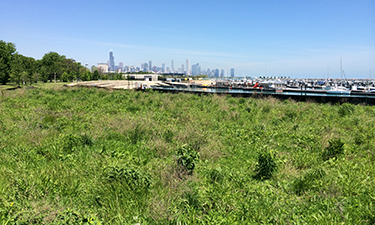 I’m peering through a dense thicket of tall prairie grasses when I see it: the magenta bloom of a New England aster. It’s not a rare plant, but it’s beautiful, and I’ve been waiting all summer to see it flower. This is a transcendent moment — I feel like I’m standing in a prairie that’s been around forever — but my bliss is quickly interrupted by the sound of a jackhammer: road construction on Lake Shore Drive.
I’m peering through a dense thicket of tall prairie grasses when I see it: the magenta bloom of a New England aster. It’s not a rare plant, but it’s beautiful, and I’ve been waiting all summer to see it flower. This is a transcendent moment — I feel like I’m standing in a prairie that’s been around forever — but my bliss is quickly interrupted by the sound of a jackhammer: road construction on Lake Shore Drive.
I’m not in a pristine ecosystem. All around me in downtown Chicago is Burnham Centennial Prairie, a restored habitat built and managed by humans to atone for the destruction of millions of acres of prairie that used to envelop the Chicago region. My job, as a Ph.D. student at Northwestern University and Chicago Botanic Garden, is to help land managers best maintain this habitat for the foreseeable future. Prairies in Illinois have been managed by humans for thousands of years, and, if we want prairies, we can’t stop. These prairies are past the point of “natural” management — if left alone, they’ll disappear.
Midwestern farming almost killed the prairie. Ordinarily, prairies return year after year because seeds and roots serve as “ecological memory.” Natural seed banks (in contrast to frozen seed vaults housed in laboratories) made up of dormant seeds, wait underground for a favorable time to germinate. Deep roots allow prairie plants to wait out the winter and quickly re-sprout in the spring. By overturning soils, plowing destroyed prairies above and below ground, so that even when land was abandoned, prairie plants didn’t return. Instead, weedy “old fields” grew. Burnham had very little ecological memory, parts of it were built on sediment dredged out from Lake Michigan and plopped onto the shore.
Building a Prairie
With so much prairie destroyed, how do managers know how to build a prairie? Mostly, they study remnants — small patches of original prairie that somehow survived farming and development, usually because they were on marginal or hard-to-reach land. Building a restoration by looking at a remnant is like trying to recreate a dish without the recipe and in a fraction of the time; it is a big challenge. Land managers have been working on the recipe for prairie restoration for more than 80 years, starting with the first restored prairie at the University of Wisconsin, Madison, but there is still much more to learn.
Studying the plant species found at a remnant is perhaps the most obvious first step to writing the recipe. If they can find seeds of these species, managers can add them to seed mixes used for restoration. But remnant prairies provide more than just inspiration, they also give managers access to the raw materials needed to build a prairie. The seeds that built the earliest restored prairies were hand-gathered from remnants. Today, restoration managers supplement wild-collected seed with those purchased from commercial prairie growers, especially for large-scale processes like Burnham. Some planted species will grow roots and produce seeds, developing ecological memory even in a restored site.
If species and seeds are ingredients for the prairie recipe, management is the cooking technique, and like much of cooking, fire is key. Burning a natural area might feel counterintuitive, but for thousands of years, fires have helped prairies rejuvenate. Fossilized pollen and charcoal remains from ancient sediments show that fire, started by lightning and/or people, has maintained the prairies of Illinois for at least 10,000 years. Fire promotes germination of some tough-seeded species, and keeps weeds at bay by giving all plants a fresh start. Given its location just south of McCormick place, between Lake Shore Drive and Lake Michigan, Burnham has very little chance of a natural grassland fire rolling though. So fire crews, with backup from the fire department, perform controlled burns every year or two.
Biodiversity in the City
Despite all the hard work that goes into restoration, restored prairies never become remnants. Restored prairies are usually less diverse; they have fewer species living together. This is because restored prairies are established all at once from any available seed, on disturbed land (or dredged sediment), while remnants have been prairies for thousands of years.
Biodiversity is a big deal because it is linked to the overall functioning of ecosystems. Diverse plant assemblages support a greater diversity of species higher up on the food chain, like insects and birds, are better at keeping out invasive weeds that can destroy native habitats, and store more carbon to help mitigate climate change. Through my research, I try to figure out how to increase the diversity of restored prairies and help managers design effective seed mixes for restoration.
Even if they can’t turn into remnants, restorations are high-quality habitat compared to the weed fields, abandoned parking lots and drainage ditches that are potential prairies. Restored prairies provide habitat and breeding grounds for migrating species like the beloved (and declining) monarch butterflies. The deep roots of prairie plants retain stormwater and reduce runoff in urban and suburban settings. Most importantly, restored prairies are an unparalleled educational resource for big and small naturalists. Restorations show Midwesterners that biodiversity isn’t just in the rainforest and tie us back to our natural history before farming and suburban sprawl. In a restored prairie, if you squint just right, you don’t even notice the highway.
Becky Barak is a Ph.D. candidate, Plant Biology and Conservation, at Northwestern University/Chicago Botanic Garden.

